by Eric Meier
When attempting to identify a wood sample, it’s important to keep in mind the limitations and obstacles that are present in our task. Before starting, please have a look at The Truth Behind Wood Identification to approach the task in a proper mindset; I consider the linked article to be required reading for all those visiting my site with the intent of identifying wood.
1. Confirm it is actually solid wood.
Before proceeding too much farther into the remaining steps, it’s first necessary to confirm that the material in question is actually a solid piece of wood, and not a man-made composite or piece of plastic made to imitate wood.
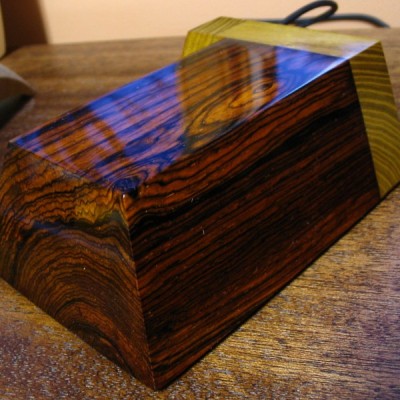
Can you see the end-grain?
Manufactured wood such as MDF, OSB, and particleboard all have a distinct look that is—in nearly all cases—easily distinguishable from the endgrain of real wood. Look for growth rings—formed by the yearly growth of a tree—which will be a dead-giveaway that the wood sample in question is a solid, genuine chunk of wood taken from a tree.
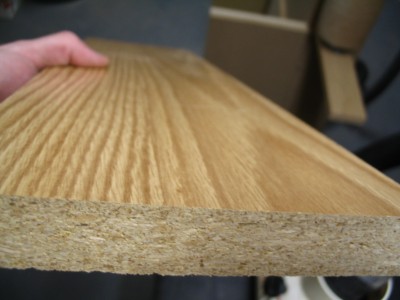
Is it veneered?
If you see a large panel that has a repeating grain pattern, it may be a veneer. In such cases, a very thin layer of real wood is peeled from a tree and attached to a substrate; sometimes the veneer can be one continuous repeating piece because it is rotary-sliced to shave off the veneer layer as the tree trunk is spun by machines. Assuming it is a real wood veneer with a distinct grain and texture—and not merely a piece of printed plastic—you may still be able to identify the outer veneer wood in question, but you should still realize that is it only a veneer and not a solid piece of wood.
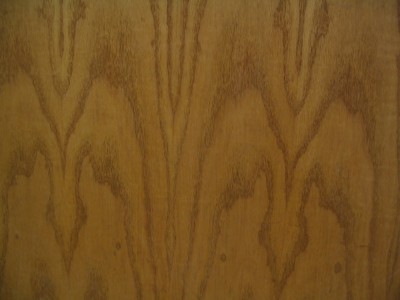
Is it painted or printed to look like wood?
Many times, especially on medium to large-sized flat panels for furniture, a piece of particleboard or MDF is either laminated with a piece of wood-colored plastic, or simply painted to look like wood grain. Many of today’s interior hardwood flooring planks are good examples of these pseudo-wood products: they are essentially a man-made material made of sawdust, glues, resins, and durable plastics.
2. Look at the color.
Some questions to immediately ask yourself:
Is the color of the wood natural, or is it stained?
If there is even a chance that the color isn’t natural, the odds are increased that the entire effort of identifying the wood will be in vain.
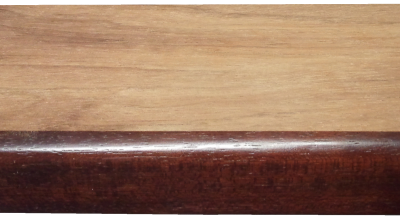
Is it weathered or have a patina?
Many woods, when left outside in the elements, tend to turn a bland gray color. Also, even interior wood also takes on a patina as it ages: some woods get darker, or redder, and some even get lighter or lose their color; but for the most part, wood tends to darken with age.
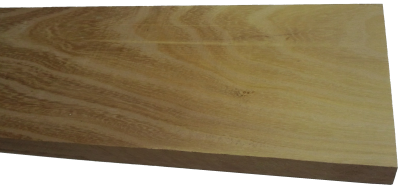
Is it possible to sand or plane the board to see the natural raw color of the wood?
The most predictable baseline to use when identifying wood is in a freshly sanded state. This eliminates the chances of a stain or natural aging skewing the color diagnosis of the wood.
3. Observe the wood grain.
If the wood is unfinished, then look at the texture of the grain. Ask yourself these questions:
Does the wood have an open, porous texture?
Most softwoods will be almost perfectly smooth with no grain indentations, while many common hardwoods have an open pore structure, such as oak or mahogany; though there are some hardwoods that are also smooth to the touch, such as maple.
Can you tell if the wood is quartersawn or plainsawn?
By observing the grain patterns, many times you can tell how the board was cut from the tree. Some wood species have dramatically different grain patterns from plainsawn to quartersawn surfaces. For instance, on their quartersawn surfaces, lacewood has large lace patterns, oak has flecks, and maple has the characteristic “butcher block” appearance.
Is there any figure or unusual characteristics, such as sapwood, curly or wild grain, burl/knots, etc.?
Some species of wood have figure that is much more common than in other species: for example, curly figure is fairly common in soft maple, and the curls are usually well-pronounced and close together. Yet when birch or cherry has a curly grain, it is more often much less pronounced, and the curls are spaced farther apart.
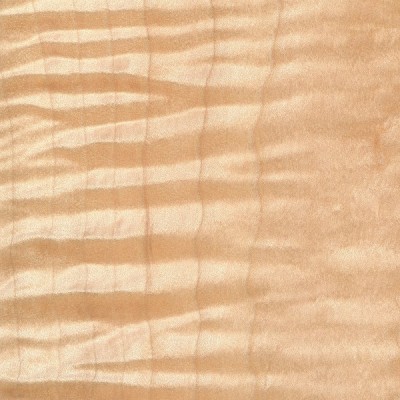
4. Consider the weight and hardness of the wood.
If it’s possible, pick the piece of wood up and get a sense of its weight, and compare it to other known wood species. Try gouging the edge with your fingernail to get a sense of its hardness. If you have a scale, you can take measurements of the length, width, and thickness of the wood, and combine them to find the density of the wood. This can be helpful to compare to other density readings found in the database. When examining the wood in question, compare it to other known wood species, and ask yourself these questions:
Is the wood dry?
Wood from freshly felled trees, or wood that has been stored in an extremely humid environment will have very high moisture contents. In some freshly sawn pieces, moisture could account for over half of the wood’s total weight! Likewise, wood that has been stored in extremely dry conditions of less than 25% relative humidity will most likely feel lighter than average.
How does the wood’s weight compare to other species?
Taking into account the size of the board, how does its weight compare to other benchmark woods? Is it heavier than oak? Is it lighter than pine? Look at the weight numbers for a few wood species that are close to yours, and get a ballpark estimate of its weight.
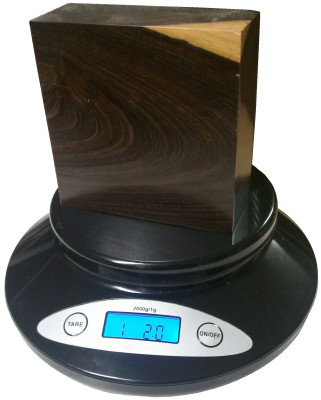
How hard is the wood?
Obviously softwoods will tend to be softer than hardwoods, but try to get a sense of how it compares to other known woods. Density and hardness are closely related, so if the wood is heavy, it will most likely be hard too. If the wood is a part of a finished item that you can’t adequately weigh, you might be able to test the hardness by gouging it in an inconspicuous area. Also, if it is used in a piece of furniture, such as a tabletop, a general idea of its hardness can be assessed by the number and depth of the gouges/dings in the piece given its age and use. A tabletop made of pine will have much deeper dents than a tabletop made of Oak. Additionally, you can always try the “fingernail test” as a rough hardness indicator: find a crisp edge of the wood, and with your fingernail try to push in as hard as you can and see if you’re able to make a dent in the wood.
5. Consider its history.
Many times we forget common sense and logic when attempting to identify wood. If you’ve got a piece of Amish furniture from Pennsylvania, chances are more likely that the wood will be made of something like black walnut or cherry, and not African wenge or jatoba. You might call it “wood profiling,” but sometimes it can pay to be a little prejudiced when it comes to wood identification. Some common-sense questions to ask yourself when trying to identify a piece of wood:
Where did it come from?
Knowing as much as you can about the source of the wood—even the smallest details—can be helpful. If the wood came from a wood pile or a lumber mill where all the pieces were from trees processed locally, then the potential species are immediately limited. If the wood came from a builder of antique furniture, or a boat-builder, or a trim carpenter: each of these occupations will tend to use certain species of woods much more often than others, making a logical guess much simpler.
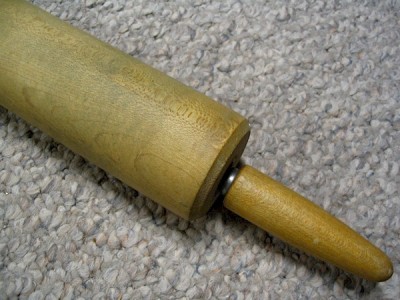
How old is it?
As with the wood’s source, its age will also help in identification purposes. Not only will it help to determine if the wood should have developed a natural patina, but it will also suggest certain species which were more prevalent at different times in history. For instance, many acoustic guitars made before the 1990s have featured Brazilian rosewood backs/sides, yet due to CITES restrictions placed upon that species, East Indian rosewood became a much more common species on newer guitars. (And this is a continuing shift as newer replacements are sought for rosewoods altogether.)
How large is the piece of wood?
Some species of trees are typically very small—some are even considered shrubs—while others get quite large. For instance, if you see a large panel or section of wood that’s entirely black, chances are it’s either painted, dyed, or stained: Gaboon ebony and related species are typically very small and very expensive.
What is the wood’s intended use?
Simply knowing what the wood was intended for—when considered in conjunction with where it came from and how old it is—can give you many clues to help identify it. In some applications, certain wood species are used much more frequently than others, so that you can make an educated guess as to the species of the wood based upon the application where it was used. For instance, in the United States: many older houses with solid hardwood floors have commonly used either red oak or hard maple; many antique furniture pieces have featured quartersawn white oak; many violins have spruce tops; many closet items used aromatic red cedar, and so forth. While it’s not a 100% guarantee, “profiling” the wood in question will help reduce the number of possible suspects, and aid in deducing the correct species.
6. Find the X-Factor.
Sometimes, after all the normal characteristics of a sample have been considered, the identity of the wood in question is still not apparent. In these instances—particularly in situations where a sample has been narrowed down to only a few possible remaining choices—it’s sometimes helpful to bring in specialized tests and other narrower means of identification.
The following techniques and recommendations don’t necessarily have a wide application in initially sorting out wood species and eliminating large swaths of wood species, but will most likely be of use only as a final step in special identification circumstances.
Odor
Believe it or not, freshly machined wood can have a very identifiable scent. When your eyes and hands can’t quite get a definitive answer, sometimes your nose can. Assuming there is no stain, finish, or preservative on or in the wood, quickly sand, saw, or otherwise machine a section of the wood in question, and take a whiff of the aroma.
Although new scents can be very difficult to express in words, many times the scent of an unknown wood may be similar to other known scents. For instance, rosewoods (Dalbergia spp.) are so named for their characteristic odor that is reminiscent of roses. Although difficult to directly communicate, with enough firsthand experience scents can become a memorable and powerful means of wood identification.
Fluorescence
While certain woods can appear basically identical to one another under normal lighting conditions, when exposed to certain wavelengths—such as those found in blacklights—the wood will absorb and emit light in a different (visible) wavelength. This phenomenon is known as fluorescence, and certain woods can be distinguished by the presence or absence of their fluorescent qualities. See the article Fluorescence: A Secret Weapon in Wood Identification for more information.
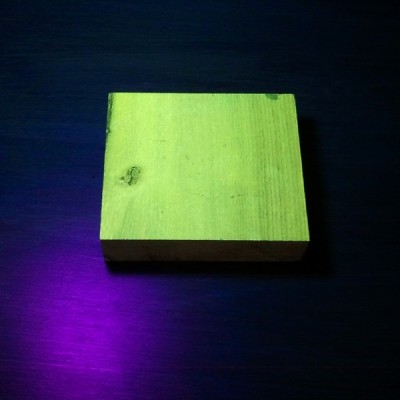
Chemical Testing
There are only a small number of chemical tests regularly used on wood, most of which are very specialized and were developed to help distinguish easily confused species with one another. They work by detecting differences in the composition of heartwood extractives. A chemical substance (called a reagent) is usually dissolved in water and applied to the wood surface: the surface is then observed for any type of chemical reaction (and accompanying color change) that may occur. Two of the most useful are the tests that are meant to separate Red and White Oak, and Red and Hard Maple.
Heartwood Extractives Leachability
Sometimes a wood species will have heartwood extractives that will be readily leachable in water and capable of conspicuously tinting a solution of water a specific color. For instance, the heartwood extractives contained in osage orange (Maclura pomifera) contain a yellowish-brown dye that is soluble in water. (This can sometimes be observed anecdotally when the wood is glued with a water-based adhesive: the glue’s squeeze-out is an unusually vibrant yellow.)
In a simple water extract color test, wood shavings are mixed with water in a vial, test tube, or other suitably small container, and the color of the water is observed after a few minutes. If the heartwood extractives are leachable by water, then a corresponding color change should quickly occur.
In addition to osage orange (Maclura pomifera), merbau (Intsia spp.), and rengas (Gluta spp. and Melanorrhoea spp.) are also noted for their readily leachable heartwood extractives. Because this property is quite uncommon, it can serve to quickly differentiate these woods from other lookalikes.
7. Look at the endgrain.
Perhaps no other technique for accurate identification of wood is as helpful and conclusive as the magnified examination of the endgrain. Frequently, it brings the identification process from a mostly intuitive, unscientific process into a predictable, repeatable, and reliable procedure.
Looking at the endgrain with a magnifier shouldn’t be a mystifying or esoteric art. In many cases, it’s nearly as simple as examining small newsprint under a magnifying glass. There are three components necessary to reap the full benefits contained in the endgrain:
I. A prepared surface.
When working with wood in most capacities, it becomes quickly apparent that endgrain surfaces are not nearly as cooperative or as easily worked as face grain surfaces. However, in this case, it is absolutely critical that a clear and refined endgrain surface is obtained.
For a quick glance of a softwood sample, a very sharp knife or razor blade can be used to take a fresh slice from the endgrain. However, in many denser species, especially in tropical hardwoods, one of the best ways to obtain a clear endgrain view is through diligent sanding. It’s usually best to begin with a relatively smooth saw cut (as from a fine-toothed miter saw blade) and proceed through the grits, starting at around 100, and working up to at least 220 or 320 grit, preferably higher for the cleanest view.
II. The right magnifier.
It need not be expensive, but whatever tool is used to view the endgrain should have adequate magnifying power. In most instances, 10x magnification is ideal, however, anything within the range of 8 to 15x magnification should be suitable for endgrain viewing. (Standard magnifying glasses are typically in the range of 2 to 4x magnification.)
These stronger magnifiers, sometimes called loupes, usually have a smaller viewing area than standard magnifying glasses. Fancier models—with built in lights, or larger viewing surfaces—are available at a premium; but the most basic models are usually only a few dollars.
III. A trained eye.
The third element that constitutes a proper endgrain examination is simply knowing what to look for. In analyzing the patterns, colors, shapes, and spacing of the various anatomical features, there is a veritable storehouse of information within the endgrain—all waiting to be unlocked. Yet, if these elements have not been pointed out and learned, the array of features will simply seem like an unintelligible jumble. The discipline of recognizing anatomical endgrain features is not easily summed up in a few sentences or even a few paragraphs, but it is nonetheless critical to the identification process. To this end, an in-depth look should be given to the various categories, divisions, and elements that constitute endgrain wood identification on the macroscopic level. (In this regard, macroscopic denotes what can be seen with a low-powered, 10x hand lens—without the aid of a microscope—rather than simply what can be seen with the naked eye.) Because the anatomy between softwoods and hardwoods is so divergent, each will be considered and examined separately:Still stumped?
If you have a mysterious piece of wood that you’d like identified, you’ve got a few options for next steps:USDA’s Forest Products Laboratory
You can mail your physical wood samples to the Center for Wood Anatomy Research.
Pros:
- Free
- Professional wood identification
Cons:
- Only available to US citizens
- Slow turnaround times (up to a month or more)
- Limited to three IDs per year
See their Wood ID Factsheet for more info.
Alden Identification Service
You can mail your physical wood samples (even small sections taken from antiques) to Alden Identification Service.
Pros:
- Professional wood identification
- Faster turnaround times (ranging from a few days to a week or two)
Cons:
- Paid service
See their ordering page for more info. (Note that Harry Alden has written several books while at USDA, including both Hardwoods and Softwoods of North America.)
Ask for help online
If the wood ID is merely a curiosity, or non-critical, you can post pictures of the wood in question.
Pros:
- Free
- No need to send physical samples
Cons:
- Greatly limited by the quality of the pictures provided
- Extra work usually required to get adequate clarity in photos
See article of Common US Hardwoods to help find the most commonly used woods.
Get the hard copy
 If you’re interested in getting all that makes The Wood Database unique distilled into a single, real-world resource, there’s the book that’s based on the website—the Amazon.com best-seller, WOOD! Identifying and Using Hundreds of Woods Worldwide. It contains many of the most popular articles found on this website, as well as hundreds of wood profiles—laid out with the same clarity and convenience of the website—packaged in a shop-friendly hardcover book.
If you’re interested in getting all that makes The Wood Database unique distilled into a single, real-world resource, there’s the book that’s based on the website—the Amazon.com best-seller, WOOD! Identifying and Using Hundreds of Woods Worldwide. It contains many of the most popular articles found on this website, as well as hundreds of wood profiles—laid out with the same clarity and convenience of the website—packaged in a shop-friendly hardcover book. 





Why I will no longer be replying to every wood ID request I’ve replied to literally thousands of wood ID requests on this site over the past 13+ years, but as the site’s popularity has grown, so has the time demands for ID on a daily basis. (Contrary to what some may seem to think, I am not some all-knowing wood wizard that can instantly ID your wood. It can actually take me a long time to sift through a lot of different resources.) Over the past few years, my backlog of pending wood species to be added to the… Read more »
Hi, I just bought this kitchen table, I am planning to refinish it and I have no idea what type of wood this is. Can you help, thanks!
Hi there, am trying to identify the wood that has been used on the cladding of our home. Would very much appreciate your help and thanks!
If you are on the East coast, probably southern yellow pine. West coast, could be douglas fir or larch.
Please would you help me out on the following questions. thank you.
Bought this chair awhile ago could you tell me the kind of wood it is and roughly how old is it.
I want to paint or varnish it what do you recommend.
Is it classified as a, Vintage grandfathers armchair.
Thank you
Can’t tell much from the pictures. It appears to have a dark mahogany or walnut stain, though it probably isn’t either of those woods.
I planned an old pallet and got this pretty wood but no idea what it is… definitely not pine
Need to attach pics
It might be cherry. Some pallets you can tell are a brighter red and usually a slightly thinner board
Hi, can you help determine if this is red oak or white oak? The first pic is how it was, second is after it’s stripped and sanded. Thanks!!
Jessica
Pics are too small and far away, sorry.
Found this in my box of offcuts. For the life of me can’t remember what it is or where I got it some 20 years ago.
I thought it might be a cherry heartwood/sapwood cut. About same hardness, weight. Wider grain though. And slightly aromatic. But never have seen anything similar at my local supplier. All the cherry we get around here is pretty uniform red.
Any ideas?
eastern red cedar
Huh. I kept thinking possibly it was sort of like aromatic/Tennessee cedar, just seemed not as aromatic, harder, and brighter colours/contrast – more red, less brown than what I’m used to. Maybe it’s just tempered with age sitting in my box. Thank you kindly.
Hi, what kind of wood is this?
I can’t tell from the pics, but overall color and look appear to resemble cherry.
This website is a wonderful resource of information! However I would like help in identifying some lumber I recently cleaned up and plan to use. I suspect it could be European Beech, as it came from Belgium ( I researched the stamp that was on it before jointing and planing ). Could anyone help identify?
I’d agree with your ID of beech. It’s one of those woods with a distinctive enough ray pattern that you can usually ID it pretty reliably just from the face grain.
I found a wood in my wood rack that I couldn’t identify. When working with it, it has a strong tar odour. It is heavier than other woods. Photos are attached. I am based in South Africa so I assume the wood may be an african wood
Eric, do you need more information to identify the wood?
Greg, sorry I must’ve overlooked this post. I am not very familiar with South African woods, so I’m not sure how much help I can be. I would probably need a clearer view of the endgrain (preferably sanded to at least 220 grit), and photographed basically as close as the camera will allow and still be in focus.
I hope these photos will help identify the wood
Thanks Greg, those are really good pictures. Unfortunately, it doesn’t look like any common commercial African hardwood that I currently have on my site. Sorry!
Thanks Eric. I will try some of the local exotic timber merchants locally
Eric, I shared the pictures with Cameron from rarewoods.co.za. He thinks it looks like Iroko. A North and West African hardwood
I could be mistaken but that looks to me like iron wood. Especially that you mentioned the tar like odour. I recently made a saloon style swing door from iron wood. It can charachterized by its dense weight, light, dark and reddish colouring, distinctive stinky/tar like smell and being really strenuous to work with yet delivers a great end product. Its one of my favourite woods. Will attach a image for you to refferance to yours. The timber in my image is freshly planed and the centre piece in the middle bottom is not iron wood, it balau which I… Read more »
Thank you for this very helpful website. I am trying to identify the wood used in a couple of benches. I have not been able to identify the wood yet myself, but I am still early in the learning curve. Any clue what it might be from these images? I estimate the density of this wood at about 42-43 lbs/ft^3 (by weighing the wood portion and dividing that by the measured volume). Thank you for any help!
looks like black walnut to me.
Thank you for your feedback! I am learning about black walnut now – what I have read so far all seems consistent with this wood.
Your site looks like a fabulous source of information and I am trying to verify if this piece is truly teak. I did view the requirements on the site for the Center of Wood Anatomy but due to the age of the piece, I did not want to attempt to get the sample they need. The information that was provided to me on my purchase was that the divider was made in Thailand during the Vietnam war and shipped to the US as a family heirloom. It is very ornate with a few different shades of coloring supposedly due to… Read more »
JPGs can be uploaded, but it may be too large a file size to upload, I think the limit is 2 megabytes. Otherwise, you can use the contact form on the About page https://www.wood-database.com/about/ to get in touch with me, and I can provide details there on attaching in email.
Century old barnwood board ripped in half and noticed the sawn edge was dark green. Any clue what this wood species is?
White oak or American Chestnut?
Hey! This is very helpful, although I am completely stumped ( no pun intended) on what type of wood this is. I’m trying to redo our kitchen and I want These exact cabinets. Any clue? Thank you!
I can’t tell from the picture, but if I had to try to recreate it, I would use wood bleach to lighten pieces of red oak, then apply a satin finish with no stain.
Red oak is my guess also
Thamk you for your great work in producing this website. It is quite a treasure. I am looking for wood to replace a broken piece from the base of a stairway. It is bent 180°, has a 1/2″ thickness and a bend diameter (OD) of 10″. I believe it is Oak, but am not sure what variety. I am also debating what method to use to bend its replacement. I am leaning toward kerf bending (there is a great guide on exactly how to do so on blocklayer.com) but I have also read about steaming and clamping. Of the thre… Read more »
Looks like red oak. I am not sure that you’d be able to use kerf bending on a shaped/profiled piece like that, but I could be wrong as I don’t have direct experience with that. Bent trim pieces are very tricky to recreate!
Hello, Thank you for the great info! We recently picked up an antique table and are in the process of refinishing. A friend thought it might be maple but I don’t recall ever seeing maple with grain this dark…we were leaning towards walnut?? Thanks so much for any insight you can offer!
Best regards, Myla
Certainly does not look like maple. The color and grain is so strange, can you get a few different shots from other angles and distances? I’m not sure what I’m looking at in that picture.
Thanks so much, Eric. It’s a little challenging to grab different angels because we started refinishing the top and the underside of the table really gives the best idea of the untouched wood. Here’s a few more photos and the last one is of the top of the table that has been stripped. Not sure what kind of wood it is but we loooove it!! Thanks so much again for your help
2
3
Hi Eric, were you able to identify any additional details from the photos?
a variety of acacia
Thank you for the help Claude. We were guessing walnut but will definitely look up acacia. Thx again
This is yellow pine (supposedly), but it also has some brown splotches. What are these splotches? It is only on one side of the wood, but it does seem to go beyond the surface. Could this be some kind of “spalting” or…?
yellow pine, or a hard pine variety
Hi can someone help me identify what wood this old church seat is, I have no knowledge at all about different wood types so I apologise now if it is a type that even I myself should no. Thank you
It’s a softwood, possibly pine.
looks like douglas fir
Can you please identify the species of this turned bowl, I recently bought from a thrift store? It is currently unsanded, unfinished. Looks like a kind of burl to me, but with all of the varieties of knots, curls, and what appears to be sapwood, I don’t have a clue. Please help? Thank-you.
The ray fleck pattern on the bottom definitely reminds me of maple, but not 100% sure. It could be maple burl. Regardless, a very nice find!
beech
Olive tree
I am trying to identify this wood and am leaning towards Ipe or Rhodesian Teak…. Very hard and very dense wood. This is an old decking material that I have salvaged and will be re-purposing. The color keeps throwing me off in my searches. Pictures are through the process of me cleaning it up. Any knowledge or help would be appreciated!
Based on the endgrain, definitely not ipe or Rhodesian teak. It looks closest to a Manilkara species, I’d guess it’s bulletwood, aka massaranduba
Thank you for your help! Certainly looks like this could be bulletwood
lacewood but the colour is not right
I did more research on the Massaranduba wood and think you were correct. Here’s another photo of the very same woof after I repurposed a small chunk of the wood. Thanks again for your help!
Can you identify this wood? 1 x 4 v-groove t&g on vaulted ceiling. (actual size 1/2″ x 3 1/2″). Light weight. Surface has clear finish. Very few knots. Probably installed 1990. Also, where could I buy more in Michigan?
Endgrain isn’t clean enough to make out the finer details, but to me, it looks most like maple. Sometimes flooring dealers sell maple with more of the heartwood included, and it can be referred to as country maple.
Eric, thanks for your evaluation. I researched further and thought it might be western red cedar. The board is very light, and feels softer than maple. Could this be an option?
Can you help identify the wood of this table? It’s very solid and heavy. These are in various lighting.
Looks like a very high percentage of sapwood in that wood. I’ve seen such a thing in furniture coming out of India that use “sheesham” aka sissoo wood. But this guess is based solely on the large amount of sapwood relative to heartwood, so not really an ID per se, as just an educated guess from very limited data.
Can someone help me identify this floor surface?
It looks like it could possibly be oak, but it’s not the best picture. Maybe try another with better lighting and clearer shot of the wood grain.
oak flooring
Can you help me figure out what kind of wood my floors are? I’m guessing they’re pine boards but not sure. Also these custom-built cabinets I have in my home. Thanks!
Another photo of the floors:
Yes, pine for the floors. Oak for the cabinets.
Id say Douglas Fir with a shellac over it
Pine floors for sure. And the chest is oak
douglas fir
Thanks! For such a comprehensive articl
can you please assist and advise what tye of wood my table is?
Thank you for the article, it was very helpful, but I am still having trouble. Which wood species would my cabinets fall under? I am in between some sort of oak or maple?
Maple
maple
Hi there…great article! Can you help me identify what type of wood my stairs are? I’m trying to match them so I can redo the stairs at the bottom that are currently stone. Thank you!!!
Judging by the limited view in the pics, it looks like construction grade softwood that’s been sanded and stained a slightly darker color. So pine with an appropriately matching stain should be a close match.
Great! Thanks! Our house is a pine log cabin, so that is what we were thinking! Much appreciated!
white pine with finish
Please help. I’m trying to find out what my banister is made of so that I can get a window sill made of the same wood. It has been oiled with clear satin so appears slightly darker that the bare wood underneath. It is a hard wood but I’m unsure what it is. The house is 1930/40 in the southwest of UK.
That last pic sure does look like english oak…
Very cool and interesting article! Can’t wait to try the fluorescent light trick. So the reason I’m visiting…I recently picked up a coffee table at a yard sale. It seemed obvious to me that whatever the wood, it was painted or manipulated somehow. When I got it home I saw this tag taped to the bottom. I’ve tried searching the ole Google, but I can’t seem to come up with anything. Any advice?
Sorry, forgot the pics. Thanks!!
I’d say unless you have a reason not to trust the tag, then I’d believe it. Solid walnut, more than likely, if in the USA, it’s black walnut. It looks like someone has spray painted it black, which is a shame, as the solid walnut I’m sure was handsome on its own. Perhaps there was a defect in the finish of the top of the table, and someone took the lazy way out.
natural black walnut with surface finish
Hi again
Here are a few more photos of the mystery wood – please advise me if you need specific photos taken. The small piece in the foreground has a freshly planed surface on it, the piece in the round is freshly bandsawed across the end (my poor bandsaw).
Many thanks
Hi Eric Thanks for this great article and for sharing your expertise so keenly. I’m a wood worker, I make celtic harps for a living and longbows for a hobby. I have recently inherited some old lumps of wood, and I am struggling to find a definitive identification and I was very much hoping you would be able to help me. I’m from the UK so I am not a US citizen, so I can’t use their service. Would you please take a look at the photos and see if you have any key knowledge that would help? I have… Read more »
It does look ebony-like, but would need to see closeup images of the endgrain. Also, are you familiar with the odors of these woods? It actually helps a lot in separating some of them, especially when it is hard to get a good shot of the endgrain since everything just appears black.
Hi there! Can anyone help me find out what kind of wood my coffee table is? Here are some pictures.
Thanks so much for your help!
At the very least, the color of the wood appears to mimic black walnut. However, I’m not so sure that the woods used in the table are actually walnut. To me, from the limited view in the pictures, it looks like an amalgamation of hardwoods and softwoods in different spots that have been stained a uniform reddish brown to resemble walnut.
Eric, just a heads up. It looks like the Forest Products Laboratory has changed things up a bit, specifically it looks like they have reduced the number of samples they will process from 5 to 3 per year per household. Maybe someone had his wife and seven kids each send in 5 samples. From their current fact sheet: “The Center for Wood Anatomy Research will identify a maximum of 3 wood specimens per household per calendar year as a free public service to private U.S. citizens.” BTW, I still have that sample of Pink Flame from Iquitos Peru for your… Read more »
Thanks, I’ll update the page to reflect the change in numbers.
Also, it’d be nice to get a Jim King original piece of pink flame wood, since I know a lot of sellers are now floating a different wood around and calling it “pink flame” but it’s not the Rinorea spp. that was the original with the amazing colors and grain. I’ve found that the stuff for sale today is actually a species of Lecythis and is, unfortunately, quite bland by comparison.
hoping you can help me identify my desk, it used to feel like it had a thick clear coat that felt like glass but now its getting less shine and feels more dry. Im trying to see if i can get it to feel like glass again “thick and shiny” feeling.
I bought a couple of solid guitar bodies on ebay. They were listed as “polished maple”, but clearly are neither. `
They’re about as dense as balsa, and soft enough to be easily marked by my thumbnail. Fluorescing with my black light revealed nothing special. The close-up image is roughly 70X. There are many similar listings for “maple” bodies with this grain, although one with a similar grain was listed as “candlewood”.
Looks and sounds a lot like paulownia to me.
Thanks, Eric. Paulownia is very similar. I can’t believe how many hours I’ve spent on your site since I began this inquiry. (It’s been a delightful time-suck.) I’m gonna post one more photo (because it looks very cool!) that I didn’t even bother to look at yesterday (because I’d accidentally allowed my flash to go off while I was shining a black light on the piece). The light combo really brought out the grain and color in a way that black light alone didn’t.
Very informative article. I’m hoping you can help me identify what type of wood my chairs are made from. They are manufactured by Paoli, however I am not sure what type of wood it is. I am hoping to sell them and wanted to ensure I give the correct description.
Hoping to identify my wood flooring. Approx 2in width and 1/4 depth, nailed in. Pictures of top side sanded down and a picture of the back side. Oak Maybe?
Probably oak.
I’m a pen turner. I recently bought some inventory and though most was marked I had six pieces that were not. I’ve looked through the database and I can’t figure it out. I’d appreciate any input thank you.
Possibly ekki for first one. Some sort of softwood for second.
I’m a pen turner. I recently bought some inventory and though most was marked I had six pieces that were not. I’ve looked through the database and I can’t figure it out.
Pine, walnut, pine
Any chance the one in the middle maybe mesquite? Just asking because of the purple reddish color. Looks like some blanks I have milled from logs here in South Texas that I know where mesquite.
I’m a pen turner. I recently bought some inventory and though most was marked I had six pieces that were not. I’ve looked through the database and I can’t figure it out.
First one, some type of softwood. Second could possibly be zebrawood — maybe check for scent. Third, no idea.
Hi Eric! Just wondered if you had any idea what this wood might be?
At first glance those drawer fronts look like some sort of ripple figure, but upon closer inspection, it appears to just a ray fleck. Probably quartersawn white oak.
Thanks Eric! Really very much appreciated. I’m getting good at this, it was my guess too :) thanks again for your help.
I just purchased this 100 year old handmade Irish table and before I try to do anything to it, would like to know what your opinion of this wood is. It is definitely handmade as the joints are obviously handmade. The wood is a yellowish wood, and resembles Oak, but it may be pine. Since pine takes stain differently than oak, I really need to find out exactly what it is. Thank you..
The wear and tear on the table initially had thrown me off in the first picture, but that third picture clearly shows a growth ring from a softwood species, not a ring porous hardwood like oak.
…… hi, is there any chance you could identify this wood for me……. it is very “hard”, marble like even!
Hi… What type of wood is this? Yes, it’s stained. House is in eastern Long Island and was built in 1978. Looking to sand & refinish. Thanks in advance!
More than likely it’s red oak. It is a stained ring porous hardwood, common woods used are oak and ash, but I think I can just make out some ray fleck in a few planks, so probably oak.
Thank you Eric! I’m surprised and pleased as oak is strong!!!
this is (poorly) sanded wood (probably varnished)….but really rough….the insides of the doors are unfinished. could you tell me what wood it is?
That second pic is like textbook example of red oak.
Hi – I have gotten at least three different answers as to what kind of wood this cabinet is made of (pine, hickory, white oak), do you have any suggestions for how I can determine what this cabinet is made of? Thank you!
It is Hickory.
Can you get a closer picture of the grain?
Hi here are some more pictures of the grain, thank you.
One more…
Do you see those dark brown streaks in the second picture? Those are resin canals, and they occur right near the growth rings — but only in a handful of softwood genera; mostly notably, Pinus.
So short answer, looks like pine.
Hi,
I have been searching online trying to determine what this is on the walls.
Thanks so much,
Payton
Oak? Whatever it is it’s beautiful. Please don’t say that you are removing it!
Hello everyone,
I’m trying to have a local carpenter make a few boxes for me and would like a nautical theme. Could anyone tell me what type of would this is?
Thanks,
Javi
So that’s a traditional Carolina flare – probably a Jarret bay or similar. The sterns on a boat like that are traditionally teak or mahogany. They could even be mahogany plywood or a veneer over a marine plywood. In reality you could get any wood to look like this with stain, and with enough epoxy, sanding, and finishing, you could make it look like that. I’m a professional boat captain, and I’ve worked on a many many wood boats (YES, that boat above is WOOD. it’s epoxy over wood- but those boats are stick build, traditional frames and marine plywood,… Read more »
Helleo again, I just realized this photo may have the clearest view of the grain, and the edge (above the clock dial) looks so different from the face of the same piece, that I’m concerned it’s a hint of inferior wood, even veneer as opposed to solid. But the grain around the clock dial seems pretty rich looking. Should I take that as good sign of mahogany? Tried reading your great article on African & S. American, but still perplexed. These photos only evidence I have. Any insights (even if unsure) so deeply appreciated! Thanks again, and sorry pushing so… Read more »
Looks like black walnut to me. The burl veneer is probably also black walnut. The only part that looks a bit ambiguous might be the top curved trim piece, which does resemble mahogany, but the rest is clearly walnut, so chances are the whole thing is just walnut.
Eric, you are amazing!!! Thank you!!! I can’t believe it! But I must, because, well, your passion and expertise as to wood being the extraordinary phenomenon they are, I have to accept this unbelievably amazing surprise! To say you made my day, an understatement! (Esp. after last time what I was hoping was mahogany you informed me was poplar!). It’s sinking in I managed to get a solid walnut clock, just unbelievable, as “poplar” is how these things often turn out. As to the trim on top, I must say I’m surprised that they’d use a lesser wood in that… Read more »
Well, apologizing if I’m being a nuisance (I saw on some other comments you asked for another photo) — Just this last picture! Thank you a million if you can help!! Obviously I’m a bit curious about the burl also (is it from random tree or identifiable?). Can’t thank you enough, not just on this but all the other info/responses on your site! Amazing!